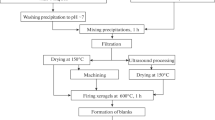Abstract
This paper presents results of a detailed study of fundamental aspects of the formation of 2D and 3D nanostructured YSZ:Yb3+ ceramics with a cubic structure through a key synthesis step in aqueous solutions of zirconium-containing hydroxy nanoparticles (1–2 nm) modified by Y3+ and Yb3+ ions, with the use of a sol–gel method and subsequent calcination of the resultant xerogels at temperatures above 350°C. As starting chemicals for the synthesis of ceramic powders, we used zirconyl, yttrium, and ytterbium nitrates and chlorides and aqueous ammonia. Using mixed solutions of these salts and a procedure developed by us, we synthesized sols, gels, and xerogels. To examine the effect of temperature on solid-state transformations, the xerogels were calcined according to a predetermined program in a muffle furnace at temperatures in the range from 350 to 1350°C (rarely, up to 1650°C). We focused primarily on ceramic powders close in composition to 0.86ZrO2 · 0.10Y2O3 · 0.04Yb2O3. The ceramics were characterized by high-resolution transmission electron microscopy, electron microdiffraction, electronic diffuse reflectance spectroscopy, energy dispersive X-ray microanalysis, and X-ray fluorescence analysis.
Similar content being viewed by others
References
Peuchert, U., Okano, Y., Menke, Y., Reichel, S., and Ikesue, A., Transparent cubic-ZrO2 ceramics for application as optical lenses, J. Eur. Ceram. Soc., 2009, vol. 29, pp. 283–291.
Ikesue, A. and Aung, Y., Synthesis and performance of advanced ceramic lasers, J. Am. Ceram. Soc., 2006, vol. 89, no. 6, pp. 1936–1944.
Tsukuma, K., Transparent titania–yttria–zirconia ceramics, J. Mater. Sci. Lett., 1986, vol. 5, pp. 1143–1144.
Muha, G.M. and Vanghan, Ph.A., Structure of the complex ion in aqueous solutions of zirconyl and hafnyl oxyhalides, J. Chem. Phys., 1960, vol. 33, no. 1, pp. 194–199.
Singhal, A., Toth, L.M., Lin, J.S., and Affholter, K., Zirconium(IV) tetramer/octamer hydrolysis equilibrium in aqueous hydrochloric acid solution, J. Am. Chem. Soc., 1996, vol. 118, no. 46, pp. 11529–11534.
Simonenko, N.M., Simonenko, E.P., Sevastyanov, V.G., and Kuznetsov, N.T., Production of 8%Y2O3–92%ZrO2 (8YSZ) thin films by sol–gel technology, Russ. J. Inorg. Chem., 2015, vol. 60, no. 7, pp. 795–803.
Lever, A.B.P., Inorganic Electronic Spectroscopy, Amsterdam: Elsevier, 1987, 2nd ed.
Hull, S., Superionics: crystal structures and conduction, Rep. Prog. Phys., 2004, vol. 67, no. 7, pp. 1233–1314.
Zavodinsky, V.G. and Chibisov, A.N., Stability of cubic zirconia and of stoichiometric zirconia nanoparticles, Phys. Solid State, 2006, vol. 48, no. 2, pp. 363–367.
Orera, V.M., Merino, R.I., Chen, Y., Cases, R., and Alonso, P.J., Intrinsic electron and hole defects in stabilized zirconia single crystals, Phys. Rev. B: Condens. Matter Mater. Phys., 1990, vol. 42, no. 16, pp. 9782–9789.
Gionco, Ch., Paganini, M.C., Giamello, E., Burgess, R., Valentin, D.C., and Pacchioni, G., Paramagnetic defects in polycrystalline zirconia: an EPR and DFT study, Chem. Mater., 2013, vol. 25, pp. 2243–2253.
Rydberg, S., Radiation induced losses in ytterbium doped laser materials, PhD Thesis, Sundsvall, 2013.
Nakazawa, E. and Shionoya, S., Cooperative luminescence in YbPO4, Phys. Rev. Lett., 1970, vol. 25, no. 25, pp. 1710–1712.
Stryganyuk, G., Trots, D., Berezovskaya, I., Shalapska, T., Voloshinovskii, A., Dotsenko, V., and Zimmerer, G., Luminescence of YbP3O9 upon excitation in the UV–VUV range, J. Phys.: Condens. Matter, 2007, vol. 19, paper 6236–6246.
Author information
Authors and Affiliations
Corresponding author
Additional information
Original Russian Text © O.P. Krivoruchko, T.V. Larina, A.V. Ishchenko, E.V. Pestryakov, M.A. Merzliakov, 2017, published in Neorganicheskie Materialy, 2017, Vol. 53, No. 5, pp. 547–555.
Rights and permissions
About this article
Cite this article
Krivoruchko, O.P., Larina, T.V., Ishchenko, A.V. et al. Sol–gel synthesis of 2D and 3D nanostructured YSZ:Yb3+ ceramics. Inorg Mater 53, 540–547 (2017). https://doi.org/10.1134/S0020168517050144
Received:
Accepted:
Published:
Issue Date:
DOI: https://doi.org/10.1134/S0020168517050144




